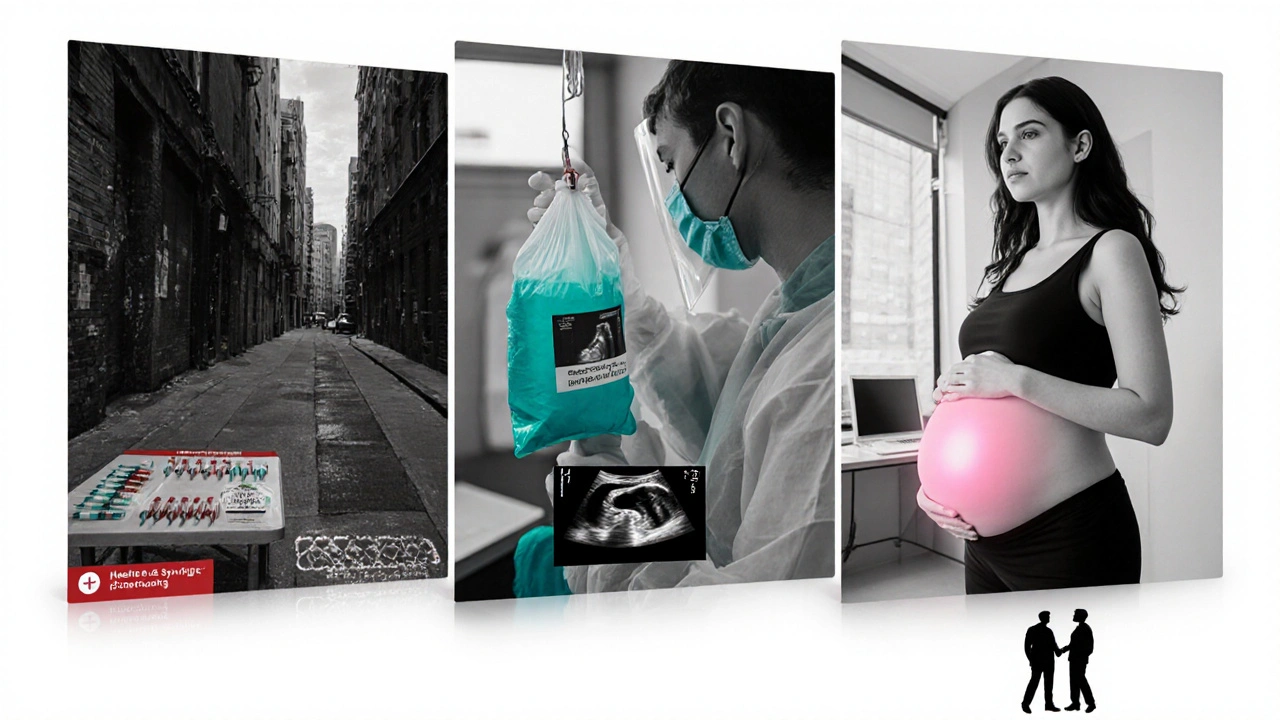Prevention Strategy Cost Calculator
Select Prevention Strategies
Choose one or more prevention strategies to compare cost-effectiveness
How It Works
This calculator determines cost-effectiveness by comparing the cost per 1,000 people to the estimated reduction in new cases.
Lower values indicate more cost-effective strategies. A value of $1,000 means $1,000 spent prevents one case.
Results
| Strategy | Reduction in Cases | Cost per 1,000 | Cost per Case Prevented | Ranking |
|---|
When doctors talk about hepatitisC, they often focus on the virus as a whole. But the story changes when you look at genotype 3 hepatitis c. This strain spreads a bit differently, progresses faster in the liver, and needs a tailored mix of public‑health moves and personal choices to keep it in check. Below you’ll find the essential facts on how genotype 3 moves from person to person, what makes it harder to treat, and the most effective ways to halt its spread.
What Is Genotype 3 HepatitisC?
Genotype 3 hepatitis C is a genetic variant of the Hepatitis C virus (HCV) that accounts for roughly 20‑30% of global infections. It was first identified in the early 1990s and is especially common in South Asia, parts of Europe, and among people who inject drugs.
Key attributes:
- RNA virus with a single‑strand genome.
- Associated with faster liver fibrosis and higher risk of steatosis (fatty liver).
- Responds well to modern direct‑acting antivirals (DAAs) but may require longer treatment durations.
How Does Genotype 3 Spread?
Understanding transmission routes is the first step to cutting the chain. While all hepatitisC genotypes share the same main pathways, genotype 3 has a few nuances.
Needle sharing is the leading driver among people who inject drugs (PWID). A single contaminated syringe can infect dozens because the virus remains viable in blood for up to 6weeks at room temperature.
Blood transfusion and organ transplantation were major routes before rigorous screening became standard in the early 1990s. In low‑resource settings, unsafe blood still fuels new cases.
Mother‑to‑child transmission occurs in about 5% of births from infected mothers, especially when viral load is high. Genotype 3 appears slightly more likely to cross the placenta than other genotypes.
Sexual transmission is less efficient but possible, particularly among men who have sex with men (MSM) living with HIV.
Other less common pathways include accidental needle sticks in healthcare settings and sharing of personal grooming items (e.g., razors) that might carry blood.
Why Is Genotype 3 Trickier Than Other Genotypes?
Two biological factors give genotype 3 its edge:
- Rapid liver fibrosis: Studies from 2023 show that genotype 3 patients develop stageF2 fibrosis about 3years sooner than genotype 1.
- Higher steatosis rates: Up to 50% of genotype 3 carriers develop fatty liver, which accelerates cirrhosis and hampers response to some DAAs.
These traits mean early detection and swift treatment become even more critical.
Screening and Diagnosis: Getting the Right Test
Because genotype 3 behaves uniquely, accurate testing matters.
- Rapid antibody test detects exposure but cannot tell genotype.
- HCV RNA PCR confirms active infection and quantifies viral load.
- Genotyping is usually done after a positive RNA test, using either sequencing or line‑probe assays.
World Health Organization (WHO) guidelines recommend a one‑step “test‑and‑treat” approach for high‑risk groups to cut waiting times.

Prevention Strategies That Work
Stopping genotype 3 from spreading needs a blend of public‑health policies, community programs, and individual habits. Below is a practical checklist.
Harm‑Reduction Programs
These are the frontline defense for PWID.
- Needle‑and‑syringe programs (NSPs) provide sterile equipment, reducing sharing by up to 80% in urban centers.
- Opioid substitution therapy (OST) (e.g., methadone, buprenorphine) lowers injection frequency, indirectly decreasing hepatitisC incidence.
- Mobile outreach units bring testing kits and safe‑injection kits directly to hotspots.
Safe Blood and Medical Practices
Even in high‑income countries, vigilance is key.
- Mandatory nucleic‑acid testing (NAT) of all donated blood cuts residual risk to less than 0.001%.
- Strict sterilization protocols for surgical instruments and dialysis machines.
- Training for healthcare workers on safe needle handling and immediate post‑exposure prophylaxis.
Maternal‑Child Prevention
Pregnant women with genotype 3 should be screened early.
- If RNA positive, start DAA therapy in the second trimester when safe, as per 2024 European Association for the Study of the Liver (EASL) recommendations.
- Elective cesarean delivery does not markedly reduce transmission, but avoiding prolonged labor helps.
- Breastfeeding is generally safe unless nipples are cracked or bleeding.
Sexual Health Measures
Condom use, regular STI testing, and HIV management reduce the already low sexual transmission risk.
Vaccination and Future Prospects
There is still no approved hepatitisC vaccine, but several candidates entered phaseIII trials in 2025. Until then, the focus stays on the measures above.
Treatment Options: The Modern Era of Direct‑Acting Antivirals
Genotype 3 responds well to the pan‑genotypic DAAs that hit the virus at multiple points in its replication cycle.
- Sofosbuvir/Velpatasvir (SOF/VEL) - 12‑week regimen with >95% cure rates for treatment‑naïve patients.
- Glecaprevir/Pibrentasvir (GLE/PIB) - 8‑week option, useful for patients with compensated cirrhosis.
- For those with advanced fibrosis, an extended 16‑week course plus ribavirin may be advised.
Adherence is crucial; missed doses can foster resistance, especially in genotype 3 where the NS5A‑inhibitor barrier is lower.
Putting It All Together: A Practical Roadmap
Below is a step‑by‑step plan that health workers, community leaders, or even an individual can follow.
- Identify high‑risk groups (PWID, pregnant women, recipients of blood products).
- Deploy rapid antibody testing at community sites.
- If positive, confirm with HCV RNA PCR and genotype the virus.
- Refer genotype 3 positive patients to a DAA‑experienced clinician within two weeks.
- Start appropriate DAA regimen (SOF/VEL or GLE/PIB) and monitor viral load at week4 and week12.
- Enrol patients in harm‑reduction or maternal‑health programs to prevent reinfection.
- Conduct post‑treatment testing 12 weeks after therapy to confirm sustained virologic response (SVR).
Integrating these steps into existing public‑health frameworks reduces new infections and improves cure rates.

Comparison of Core Prevention Strategies
| Intervention | Primary Target Group | Estimated Reduction in New Cases | Implementation Cost (USD per 1,000 people) |
|---|---|---|---|
| Needle‑and‑Syringe Programs | PWID | ≈70% | 1,200 |
| Universal Blood Screening (NAT) | Blood donors | ≈95% | 3,500 |
| Maternal Screening & DAA Treatment | Pregnant women | ≈85% | 2,800 |
| Sexual Health Education + Condoms | General population, MSM | ≈15% | 500 |
| Opioid Substitution Therapy | PWID with opioid dependence | ≈60% | 2,200 |
Common Pitfalls and How to Avoid Them
- Assuming a negative antibody test means no risk. Early infection may not yet have produced antibodies - repeat testing after 3months if exposure is suspected.
- Skipping genotype testing and prescribing a generic DAA regimen that isn’t optimal for genotype 3 can lower cure rates.
- Neglecting post‑treatment counseling; reinfection rates among PWID can rise to 5% per year without continued harm‑reduction support.
- Relying on outdated guidelines - the 2024 WHO update shortened treatment for many genotype 3 patients to 8 weeks with SOF/VEL.
Future Directions
Three trends will shape the fight against genotype 3 in the next five years:
- Long‑acting injectable antivirals - PhaseII trials show a single 6‑month injection can maintain viral suppression.
- Point‑of‑care genotype testing - Portable PCR devices can deliver results in under 30minutes, enabling same‑day treatment.
- Vaccine candidates targeting conserved HCV epitopes are moving into phaseIII, promising the first true preventive tool.
While these innovations mature, the current toolbox of testing, DAAs, and harm‑reduction remains the most reliable way to curb genotype 3 transmission.
Frequently Asked Questions
Is genotype 3 more dangerous than other hepatitisC genotypes?
Yes. Research up to 2024 shows genotype 3 causes faster liver fibrosis and a higher incidence of fatty liver, which together increase the risk of cirrhosis and liver cancer compared with genotypes 1 and 2.
Can I get hepatitisC from casual contact?
No. The virus needs blood-to-blood contact. Sharing needles, a blood transfusion before 1992, or mother‑to‑child transmission are the real risks.
How long does treatment for genotype 3 usually last?
Current WHO guidelines recommend a 12‑week course of sofosbuvir/velpatasvir for most patients. Some without cirrhosis can complete an 8‑week regimen of glecaprevir/pibrentasvir.
Is there a vaccine for hepatitisC?
Not yet. Several candidates are in phaseIII trials as of 2025, but no vaccine has been approved for public use.
What should a pregnant woman with genotype 3 do?
She should be tested early in pregnancy. If RNA positive, a DAA regimen like sofosbuvir/velpatasvir can be started in the second trimester under specialist supervision, dramatically lowering the chance of mother‑to‑child transmission.


Comments (9)
Genotype 3 definitely deserves its own spotlight – it spreads a bit faster and the liver damage can sneak up on you. The needle‑sharing route is still the biggest culprit, especially in communities where harm‑reduction services are scarce. If you’re lucky enough to get screened early, the new DAAs can clear the virus in most cases.
Wow, the tables are turning – genotype 3 is the sneaky ninja of Hep C.
From a virological standpoint, genotype 3's proclivity for rapid fibrosis is linked to its unique NS5A polymorphisms, which modulate host lipid metabolism pathways. This mechanistic nuance explains the higher steatosis prevalence and why conventional DAA regimens sometimes need adjustment.
Indeed, the data underscores the public‑health imperative: screen, treat, and prevent – especially in high‑risk groups (PWID, pregnant women, blood donors). The table you included is a fantastic visual aid!!!
Adding to that, community outreach programs that combine rapid testing with immediate DAA initiation have shown cure rates soaring above 90% in underserved areas. It’s a win‑win for patients and the health system.
Ah, genotype 3 – the misunderstood rebel of the hepatitis C family. First off, let’s get one thing straight: it’s not some mystical beast that magically evades treatment; it’s just a bit more finicky, and that makes for an interesting discussion. The virus’s affinity for causing steatosis isn’t a random quirk – it hijacks the host’s lipid pathways, turning the liver into a greasy mess that accelerates fibrosis. That’s why you’ll see patients presenting with cirrhosis earlier than with genotype 1, and why early detection is crucial. The good news? Modern pan‑genotypic DAAs, especially sofosbuvir‑based combos, have cracked the code – cure rates now hover around the mid‑90s percentile, even for genotype 3. However, the devil is in the details: short‑duration regimens can be a gamble if the patient has advanced fibrosis; extending therapy to 12 or 16 weeks often salvages those tricky cases. Let’s not forget the public‑health angle – needle‑and‑syringe programmes slash transmission by up to 80%, a statistic that should make policymakers sit up and take notice. Likewise, universal NAT screening of blood products nearly eliminates the transfusion risk, but low‑resource settings still lag behind. Maternal‑child transmission is another front line; early pregnancy testing and second‑trimester DAA therapy can slash vertical transmission to below 2%, a massive leap from historical numbers. Sexual transmission, while low, isn’t zero, especially among MSM with HIV – condom use and regular STI screening are low‑effort, high‑impact strategies. And for the stubborn few who still share razors or get stuck with accidental needle sticks, education is the cheap, effective armor we need. Looking ahead, the horizon looks promising: long‑acting injectable antivirals could reduce adherence hassles, point‑of‑care genotype testing will bring same‑day treatment decisions, and vaccine candidates are finally showing phase III promise. Until those breakthroughs become mainstream, the combination of robust screening, harm‑reduction, and timely DAA therapy remains our best bet to tame genotype 3’s mischief. So, in short, treat fast, prevent wisely, and keep the public‑health gears well‑oiled.
All that sounds great, but you know the real issue is the pharma lobby hiding the long‑acting shots until they’re ready to cash in 💊🚀. Meanwhile, we’ve got people still dying because the system can’t get the cheap DAAs out fast enough.
Sure, the WHO guidelines are updated, but the bureaucracy in low‑income countries still drags its feet. The “test‑and‑treat” model is a pipe dream without funding.
Hey folks, just wanted to add that when you’re counseling a patient about genotype 3, it helps to break down the steps: test, confirm with RNA PCR, genotype, then start the appropriate DAA. Keeping it simple encourages adherence, especially for those juggling work and family.